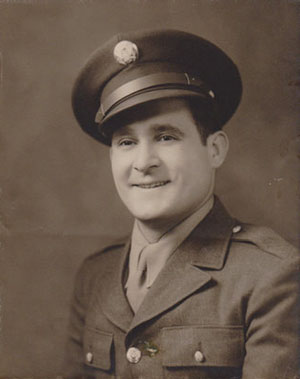
Courtesy Africano family

Remember...
Sullivan John Africano
1919-1944
"He stands in the unbroken line of patriots who have dared to die that freedom might live, and grow, and increase its blessings."
Pvt. Sullivan John Africano was born on March 8, 1919. His parents were John and Julia [Guilia] Africano, Italian immigrants who lived in Granville, Monongalia County, West Virginia. The 1930 Federal Census lists John as a laborer and indicates he worked in a coal mine, an occupation that young Sullivan would follow after completing grammar school and attending Riverside Junior High School. Sullivan's siblings included Andrew (who was born while the family still lived in Italy), Samuel, Mary, Louis John, Rose, Julia, Irene, Frances, and Joan.
Sullivan enlisted in the U.S. Army on December 16, 1942, at Clarksburg, West Virginia. He was assigned to the 83rd Chemical Mortar Battalion, which trained at Edgewood Arsenal, Maryland, and Fort Gordon, Georgia. Although it was customary for newly enlisted soldiers to come home on furlough between boot camp and active duty, John Africano says rumors indicated his father's unit "would not be furloughed. So my mother went to Georgia to be with him for several weeks before he left camp." Sullivan John Africano would leave the States in September 1943.
Much later:in 1945:his brother Sam, although older, would also join the Army and serve at Fort Dix, New Jersey. Louis John had entered the Navy at Norfolk, Virginia, in 1941:he was at Pearl Harbor at the time of the attack on America:and served in the South Pacific before coming home to graduate from West Virginia University. The three Africano men are pictured in Young American Patriots, Vol. 1 (Richmond, VA: National Publishing Co., 1946), p. 955.
Pvt. Africano was one of the many Americans who were killed in the sinking of the LST 422, the story of which Terry Lowry recounts in Bastard Battalion: A History of the 83rd Chemical Mortar Battalion in WWII (Charleston, WV: 35th Star Publishing, 2009). In mid-January 1944, plans for an amphibious invasion of Anzio and Nettuno, Italy, were underway, and by January 22, the beaches adjacent to these two cities had been cleared. The 83rd was heavily involved in this operation.
What happened that night has been called one of the greatest naval tragedies of the war. Although some accounts indicate there was an explosion not long after midnight, and it was originally thought the ship had been hit by a torpedo, the most accurate account is probably that of Broadhurst. He reported that around five-twenty a. m., the ship was blown into a minefield and struck a mine. Survivors remarked that they had noticed a sulfurous smell, which is consistent with a mine strike. By five-twenty-five, Broadhurst had given the order to abandon ship (though this fact is sometimes disputed by those who indicated that the ship's communication system had been knocked out).
A variety of naval vessels:many of them minesweepers:began rescue efforts, and in the chaos of the rescue, LCI 32:searching for survivors:also hit a mine. While a number of men were rescued, the horrid weather conditions:wind, cold, hail, and rain:probably accounted for many of the deaths; those not killed immediately by explosions, fire, or drowning would have become subject to hypothermia. Pvt. Africano would be one of the unlucky ones not rescued that night. Among the many citations he would receive was a Purple Heart.
Lowry says: "Although it came at a high cost, and certainly not by intent, the 83rd had once again led the way in innovations, this time impacting future naval rescues" (p. 162). He points out that rescuers (and survivors) noted the inadequacy of the life belts and jackets on the LST and of the lifesaving devices. Also stressed was the importance of rapid rescue in rough and icy waters and the need for better training in first aid.
Family information and pictures provided by Sullivan J. Africano's son John. Article by Patricia Richards McClure, with assistance from Terry Lowry

West Virginia Archives and History welcomes any additional information that can be provided about these veterans, including photographs, family names, letters and other relevant personal history.